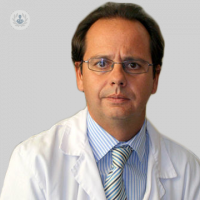Stroke: how to recognize them and what to do to prevent them
Written by:A stroke is an abrupt disorder of brain irrigation that alters the function of a particular region of the brain. There are two types:
- Cerebral infarction : occurs when an artery in our brain is obstructed by a thrombus, leaving a part of our brain without blood. After a few hours, if it is not unblocked, that part of the brain will die leaving some irreversible sequelae. If the thrombus occurs in the brain itself is called Cerebral Thrombosis. If the thrombus comes from the heart then it is known as Cerebral Embolism .
- Cerebral haemorrhage: occurs when an artery in our brain breaks, leaving the blood inside our brain in the form of a hematoma. This is why it is commonly known as Stroke .
In Spain, stroke is the second cause of death (the first among women), and affects 110,000-120,000 Spanish people each year; of them, about 70,000 die or are disabled. To date, there are more than 300,000 Spaniards who have some limitation in their functional capacity after having suffered a stroke.
In the last 20 years, mortality has decreased due to improvements in the early detection of symptoms and control of major risk factors, as well as the introduction of very effective therapeutic measures - such as the care provided by the Units of stroke and reperfusion treatments (intravenous thrombolysis and mechanical thrombectomy). However, the World Health Organization (WHO) predicts an increase in its incidence of 27% between 2000 and 2025. According to data from this organization, acute cerebrovascular diseases or stroke represent the third leading cause of death in the Western world, the first of physical disability in adults and the second of dementia.
Risk Factors for Stroke
Strokes can occur at any age, but they are much more common after age 65. In people under 40, they are caused by congenital abnormalities where some cerebral arteries have developed abnormally and tend to rupture (cases of Alberto Contador or Silvia Abascal).

In people between 40 and 60 years, the incidence of stroke has increased greatly because this group of the population begins to present risk factors that many times unknown. Thus, tobacco, poor diet, physical inactivity, obesity, high cholesterol and, more importantly, high blood pressure , are causing stroke in very young people.
We should not forget the important relationship between diabetes and stroke. Both type I and type II diabetes increase the risk of stroke at any age. Of particular importance is the association of hyperglycemia with obesity and dyslipidemia.
From the age of 65, in addition to all of the factors mentioned above, heart disease also occurs, especially a type of arrhythmia called Atrial Fibrillation , in which one part of the heart stops contracting and blood stagnates forming thrombi which can break off and travel to the brain, resulting in stroke.
The chances of successfully treating a stroke depend on the speed of action at the time the first symptoms appear
As previously mentioned, every diabetic patient has a higher risk of having a stroke, especially if he is also hypertensive. Time plays a fundamental role in the treatment of the disease , so it is important to act quickly to reduce the risk of sequelae or loss of life. For this, it is important that we learn to know the symptoms:
- Sudden loss of strength of the face, arm and / or leg on one side of the body.
- Sudden sensitivity disorder, "cramping or tingling sensation" of the face, arm and / or leg on one side of the body.
- Sudden loss of partial or total vision in one or both eyes.
- Sudden speech disturbance, difficulty in expressing oneself and being understood by the listener.
- Sudden headache of unusual intensity and without apparent cause. However, in most strokes DO NOT HURT THE HEAD .
- Sensation of vertigo, imbalance if accompanied by any previous symptom.
These symptoms, which translate is that we are suffering a CEREBRAL ATTACK , just as serious as a heart attack. At the time symptoms appear it is important to call 112 or go to the nearest hospital with Stroke Unit. In addition, even if the symptoms disappear within a few minutes, it is important to put them in the hands of neurologists as this may be the last chance to prevent an increased cerebral infarction.
Treatment of Strokes

Patients and neurologists have very little time to cure the stroke. In the worst case only 4 and a half hours, and in the best 8 hours since the onset of symptoms. That is why speed is essential.
Out-of-hospital emergency services notify the neurologist on duty from the patient's home, warning that they will be at the hospital's door in 20-30 minutes (ICTUS CODE). The neurologist receives the patient and after exploring and analyzing the patient, the patient is quickly transferred to Radiology to perform a CT scan. With that test the neurologist determines if it is a stroke or a stroke, and what artery and which parts of the brain are affected.
In the case of cerebral infarcts we can administer a drug through the patient's vein before 4.5 hours from the beginning of the symptoms to dissolve the thrombus ("thrombolysis") and save the patient's brain. In the most severe cases, where the thrombus size is very large or when the patient takes more than 4.5 hours of evolution, we take the patient to the Neuroradiology room to try to extract the thrombus from the center of the brain (mechanical thrombectomy) with a tube very flexible (catheter) that is inserted through an artery in the groin. At its tip has a kind of corkscrew or clamp with which to hook the thrombus and remove it.
In the case of cerebral hemorrhages, the treatment consists of a good control of the arterial pressure, and only in the most serious cases a surgical intervention that evacuates the cerebral hematoma.
In any case, all strokes should then enter the Ictus Unit where they receive neurological care and initiate rehabilitation.
Once the patient is stabilized it is very important that the neurologist make a diagnosis to find out what has caused the stroke in order to be able to initiate preventive measures so that it does not happen again.
Recommendations to prevent stroke
- Perform moderate exercise.
- Maintain a healthy and balanced diet low in salt and fats.
- Perform periodic weight, blood pressure, cholesterol and sugar checks. Also, if you are over 65 years old, it is important that you take your pulse periodically so that you can detect atrial fibrillation, the most common cardiac arrhythmia in adults and one of the main causes of embolic stroke.
- Maintain a blood pressure lower than 135 of maximum and 85 of minimum.
- Quit smoking.
- Quickly go to a hospital with an Ictus Unit in the case of presenting symptoms suggestive of a stroke (loss of vision, language impairment, loss of strength or tenderness in the extremities ...) although they have had a short duration. It is a warning that something more definitive may happen soon.
- After a stroke, all the measures already described must be performed, but the treatment prescribed by the neurologist must be followed (in many cases some of these treatments will last for a lifetime). The prescribed drugs will be to lower blood pressure and cholesterol, to control diabetes and, in the case of cerebral infarctions, a series of drugs that make the blood more liquid and thus try to prevent new thrombi. If the patient who has had Cerebral Thrombosis will receive aspirin or clopidogrel and if an embolism has been an anticoagulant.
- In this field, there are important advances given that we have newer, safer and more effective drugs (dabigatran, rivaroxaban, apixaban or edoxaban) than the well-known Sintrom, which required periodic blood tests and its efficacy was highly variable. In this sense, all scientific societies recommend using this group of direct anticoagulants.
- It is necessary to control cholesterol levels a lot, being optimal after a stroke to have LDL ("bad") cholesterol below 70 mg / dl.


